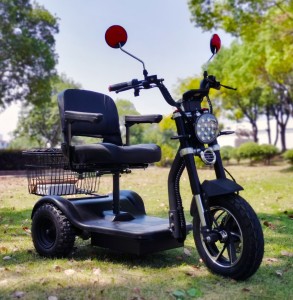How do E-Trikes compare to mobility scooters in terms of ease of use?
When it comes to choosing between e-trikes and mobility scooters, ease of use is a crucial factor that can significantly impact the user experience, especially for those relying on these devices for daily mobility. Both options offer unique advantages, but their design, functionality, and handling characteristics set them apart in various scenarios. Let’s delve into a detailed comparison to help you understand how they stack up in terms of ease of use.
Operational Complexity
Mobility scooters are often praised for their straightforward operation, making them an excellent choice for users who prefer simplicity. Most models feature intuitive controls, typically a tiller or steering wheel that responds smoothly to gentle movements. The acceleration and braking systems are designed to be user-friendly, with thumb levers or foot pedals that require minimal force to operate. This simplicity is particularly beneficial for individuals with limited hand strength or dexterity, as it reduces the learning curve and allows for quick adaptation.
E-trikes, on the other hand, have a slightly steeper learning curve due to their three-wheeled design and more complex handling. Steering an e-trike requires a bit more coordination, especially when navigating tight turns or uneven surfaces. The braking system may also differ, with some models using hand brakes that demand a firmer grip compared to the more effortless controls of mobility scooters. However, once users get accustomed to the handling, e-trikes can become just as easy to operate, especially for those who have prior experience with bicycles or similar three-wheeled vehicles.
Stability and Balance
Stability is a key aspect of ease of use, especially for users with mobility issues or balance concerns. Mobility scooters excel in this area, thanks to their low center of gravity and wide wheelbase. This design provides a stable platform that minimizes the risk of tipping, even when turning at moderate speeds or traversing slightly uneven terrain. Users can feel confident and secure while riding, which contributes to a more relaxed and enjoyable experience.
E-trikes also offer good stability, but their performance can vary depending on the model. The three-wheeled configuration provides a solid base, but the higher center of gravity compared to mobility scooters means they may be more prone to tipping if not operated carefully, especially on sharp turns or rough surfaces. However, many modern e-trikes are equipped with advanced suspension systems and wider tires to enhance stability and provide a smoother ride.
Maneuverability in Tight Spaces
Mobility scooters are generally more maneuverable in tight spaces, such as narrow hallways, crowded stores, or small apartments. Their compact size and tight turning radius allow users to navigate through confined areas with ease, making them ideal for indoor use. This maneuverability is a significant advantage for individuals who need to move around in small spaces on a regular basis.
E-trikes, due to their larger size and longer wheelbase, can be more challenging to maneuver in tight spaces. They require more room to turn and may struggle to fit through narrow doorways or navigate around obstacles in confined areas. This makes them better suited for outdoor use, such as on sidewalks, parks, or suburban streets, where there is more space to move freely.
Parking and Storage
Parking and storing a mobility scooter is relatively easy, thanks to its compact design. Many models are lightweight and can be disassembled into smaller parts, making them easy to transport in a car trunk or store in a closet or garage. Even when fully assembled, they take up less space than e-trikes, which is a big plus for users with limited storage space.
E-trikes, on the other hand, are larger and bulkier, which can make parking and storage more challenging. They require more space to park, whether in a garage, driveway, or public parking area. Disassembling an e-trike is often more complicated and time-consuming, and even when disassembled, the parts may still be too large to fit in a small car. This can be a drawback for users who need to transport their vehicle frequently or have limited storage space at home.
Comfort During Long Rides
Comfort is another important factor to consider when evaluating ease of use, especially for users who plan to take long rides. Mobility scooters are designed with comfort in mind, featuring padded seats, backrests, and armrests that provide support during extended periods of use. The suspension systems in many models also help to absorb shocks from rough terrain, ensuring a smooth and comfortable ride.
E-trikes can also be comfortable, but their comfort level depends on the design and features of the specific model. Some e-trikes come with ergonomic seats and suspension systems, while others may have a more basic design that can be less comfortable during long rides. Additionally, the riding position on an e-trike is more upright than on a bicycle, which can be more comfortable for some users, but others may find it less natural over time.
Maintenance Requirements
The maintenance requirements of a vehicle can also affect its ease of use. Mobility scooters are generally low-maintenance, with simple mechanical systems that are easy to repair and maintain. Routine maintenance tasks, such as checking the battery, tires, and brakes, can be done by the user with minimal technical knowledge. Replacement parts are also readily available and relatively inexpensive.
E-trikes, on the other hand, have more complex mechanical systems, including motors, batteries, and drivetrains, which can require more frequent and specialized maintenance. Repairs may need to be done by a professional, which can be more costly and time-consuming. Additionally, replacement parts for e-trikes may be less readily available, especially for older or less common models.
Conclusion
In conclusion, both e-trikes and mobility scooters have their own strengths and weaknesses when it comes to ease of use. Mobility scooters are simpler to operate, more maneuverable in tight spaces, easier to park and store, and require less maintenance, making them a great choice for indoor use and users who value simplicity and convenience. E-trikes, on the other hand, offer better stability on outdoor terrain and can be more comfortable for some users during long rides, but they are larger, less maneuverable in tight spaces, and require more maintenance.
Ultimately, the choice between an e-trike and a mobility scooter depends on the user’s specific needs and preferences. If you primarily need a vehicle for indoor use or navigating tight spaces, a mobility scooter is likely the better option. If you plan to use your vehicle mostly outdoors and value stability and comfort during long rides, an e-trike may be more suitable. By carefully considering these factors, you can make an informed decision that will ensure you get the most out of your mobility device.
Post time: Aug-18-2025



